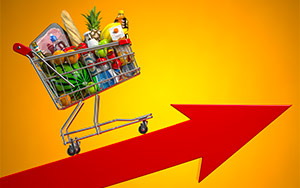
With out-of-stock warnings on the rise and consumer demand overwhelming supply chains, retailers everywhere are facing inflationary pricing. In order to maintain their margins, retailers must decide the best ways to deal with the rising costs of goods without dumping it all on the customers and risking their loyalty.
Price Increases Across the Board
“At NielsenIQ, we have identified the drivers of input cost inflation as massive disruptions in the global supply chain, causing unprecedented increases in shipping costs (+300% year-over-year), a surge in commodity prices (+33% year-over-year), and increases to energy costs (+20% year-over-year) concurrently with a global demand surge as the world adjusts to the pandemic recovery period,” Marc Santos, Vice President of North America Sales for NielsenIQ, said. “As these factors have forced unit costs up, prices have followed, resulting in inflationary price conditions we are seeing across retailers and markets.”
Inflationary pricing is something retailers have always had to deal with, but the pandemic certainly accelerated this issue. Dan Surtees, Vice President of Strategy and Business Development at XCCommerce, said he thinks this concern will continue into 2022. The supply chain issues are not going away anytime soon, and with the extended workforce concerns and increased cost of manufacturing, price increases will persist and will inevitably trickle down onto retailers. We are also now dealing with a new disruptor, the new Omicron strain of COVID, which throws everything up in the air.
How to Handle Inflationary Pricing
“Brands should be using advanced analytics to project the impact of everyday or promoted price changes at both the market level and store level,” Santos said. “Using advanced pricing models to identify volume or profitability tipping points as well as potential opportunities to set their brand apart on price allows these manufacturers to optimally activate this crucial commercial lever, even in an inflationary environment.”
Surtees also has some advice for retailers. He has been working with brands for a number of years and therefore understands the types of promotions they try to accomplish when disruptions happen in the industry. When prices go up, a natural tendency for retailers is to slash prices across the board, but according to Surtees, this tactic has proven not to work. “Look at it in a more creative and strategic way from a promotional standpoint. Build a strategy that you want that will be effective for your brand or organization,” he said. Surtees recommends:
- Personalized Promotions. Instead of promoting across an entire organization, come out with more personalized promotions. Retailers have access to so much data on customers and where they shop that they can create a strategy for promotions to target an individual.
- Promote What You Want. This means instead of promoting all of your products or an entire category, just promote some key items. This can include higher margin merchandise, or items that are currently overstocked, and then of course slow-moving products to get them out of your store.
- Increase Customer Promotions Designed for Customer Loyalty. You can use promotions to try and bring customers back into your store, but the problem with that is they are only good for one time use. So instead, retailers can offer a promotion where, for example, every $50 that a customer spends during a certain time period, they will receive a $5 off coupon that can be used towards their next purchase. If you can create a promotion that continues over a period of time over multiple transactions, you can successfully bring shoppers back into stores or online and get more sales.
“There will be demand shifts in 2022 that could be opportunities or challenges for retailers. At NielsenIQ, we are forecasting that necessity will be a driving force influencing consumer decisions, with their assessment of need stemming primarily from whether the items they purchase are good for their well-being or align with their values. Retailers may need to modify their assortment and promotional approaches to align with this consumer trend,” Santos said.